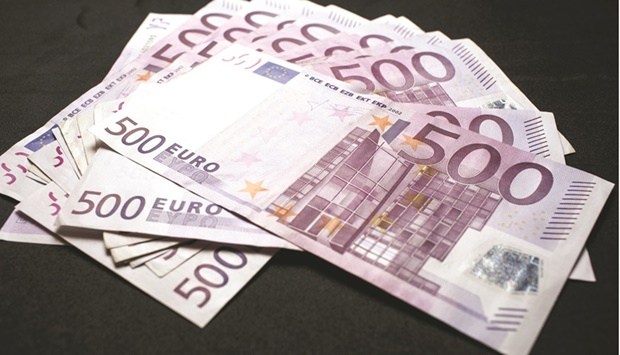The euro is on the verge of US dollar parity for the first time in two decades. Europe’s common currency has already slumped to a five-year low near $1.03, buckling from a rush into the greenback as a haven from market turmoil and on the war in Ukraine. That’s led the likes of HSBC Holdings Plc and RBC Capital Markets to predict the two will hit parity in 2022.
Hedge funds are already betting on it. They’ve piled on $7bn in notional value into options wagers on parity in the past month alone, making it the most popular trade among those looking for a further drop in the common currency.
“The euro itself is not an attractive currency at the moment,” said Francesco Pesole, a currency strategist at ING Group NV. While the Dutch bank is keeping its official euro forecast for the next six months at $1.05, Pesole admits the dollar’s strength and market volatility means parity is likely.
To a large extent the euro’s plight is a function of dollar strength, which has been supercharged as the Federal Reserve presses on with bigger interest-rate hikes than its peers. A fresh bout of global risk aversion that has taken the wind out of equity and credit markets is only adding momentum to the move into haven currencies.
There’s also a darkening outlook for the European economy. A continuing standoff with Moscow over the supply of natural gas to the continent has raised the prospect of a pronounced slowdown. The International Monetary Fund has slashed its 2022 growth forecast for the currency bloc to 2.8%.
That’s left the European Central Bank walking a tightrope. It has to balance the need for tighter policy to tame record inflation against the prospect of the economic damage that could cause – especially in some of the region’s most indebted member states such as Italy.
While officials may raise rates above zero before the end of the year, there are doubts over further hikes beyond that.
Investors will be watching speeches from the likes of ECB President Christine Lagarde in coming days, as well as the minutes of the bank’s April meeting on Thursday, for further clues on thinking. Lagarde has joined a crowd of policy makers signalling a hike as soon as July.
“I think it’s politically difficult for many in the ECB to sound too dovish, considering that inflation has likely not yet peaked,” said Peter McCallum, a rates strategist at Mizuho International Plc.
“Unless we get 50 basis-point hikes being talked about, it’s tough for many of the hawks to surprise the market now.”
Any renewed selloff in the euro that breaches the January 2017 low of $1.0341 – almost touched on both Thursday and Friday – could set the currency up for further losses.
With the region’s bonds also being dumped, the currency market may start to factor in debt risks in the eurozone, according to HSBC Holdings Plc strategists including Dominic Bunning. The spread between Italian and German yields – seen as a risk gauge – topped 200 basis points this month for the first time since the early days of the pandemic.
Not everyone is negative. Roberto Mialich, a currency strategist at UniCredit SpA, expects the euro to climb back above $1.10 in the course of next year as the Fed’s hiking cycle tails off. He sees a lasting below-parity scenario as just a tail risk, and only likely if eurozone growth slumps far more than feared.
Yet as long as risk assets remain vulnerable, traditional havens like the dollar and the yen will stay in vogue. Russia’s war in Ukraine also remains a major headwind for the euro, particularly given the prospect of further disruptions in gas supplies.
“The euro has already faced more downward pressure than we expected, but we find it hard to see a silver lining for the single currency at this stage,” HSBC strategists wrote in a note, pointing to downward revisions to growth forecasts and upward revisions for inflation. “This is a nasty cocktail for any currency to try to digest.”
UK labour data is due as well as inflation figures for April, which are expected to show consumer prices rose an annual 9.1% from 7% in March, according to the median estimate of economists surveyed.
For the euro-area, the minutes of the latest ECB meeting will be released, albeit there may be few surprises given the raft of central bank policy makers that have expounded their views.
As well as the minutes, speakers this week include ECB Executive Board member Luis de Guindos and ECB President Christine Lagarde. BoE rate setters Andrew Bailey, Dave Ramsden, Jonathan Haskel and Michael Saunders will be grilled by lawmakers today.
European government bond issuance volume should pick up to about €25bn this week, with supply from countries including Germany, France, Spain, Finland and Slovakia, according to Commerzbank AG.

A collection of euro banknotes in an arranged photograph in Madrid. Europe’s common currency has slumped to a five-year low near $1.03, buckling from a rush into the greenback as a haven from market turmoil and on the war in Ukraine.


